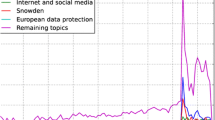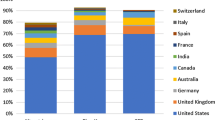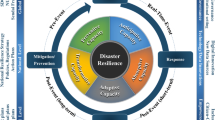Abstract
Information about events can be opportunistically harvested from social media, however, a major challenge is assessing the credibility of the information derived, and the credibility of the micro-bloggers who are the source of the information. Witnesses to events are intrinsically linked with credibility for many disciplines including journalism and the criminal justice system. This research seeks to determine whether likely witness accounts of an event can be differentiated from social media feeds. A conceptual model of a witness account, and related impact accounts and relayed accounts is developed. Additionally, influence regions defining a relationship between witnesses and events are inferred, from different categories of witness accounts. This model is explored and tested using a bushfire event as a case study. In depth manual analysis of Twitter data related to this event and its effects, confirms the expected revelations of characteristics of direct observations of a bushfire that witnesses report, and the impacts and actions potential witnesses report. A visualisation of influence regions for smoke and traffic congestion observations is provided. Additionally, for the case study event, it is observed that witness accounts contain fewer place name references, but more personal place descriptions such as ‘my home’. These findings suggest implications for automatic data mining from place descriptions that will enable an assessment of the credibility of extracted event information.




Similar content being viewed by others
Notes
As identified by the Fires Services Commissioner Victoria http://www.firecommissioner.vic.gov.au/our-work/review/community-response-to-bushfires-during-201213-fire-season/.
https://twitter.com/tetzlol/statuss/303350066230460416 Access date 18 February 2013.
https://twitter.com/taitems/status/303351685848379392 Access date 18 February 2013.
http://emergency.vic.gov.au/map#now Access date 18 February 2013 approximately 21:00.
References
Bishr, M., & Mantelas, L. (2008). A trust and repuatation model for filtering and classifying knowledge about urban growth. GeoJournal, 72(3–4), 229–237.
Boettcher, A., & Lee, D. (2012). EventRadar: A real-time local event detection scheme using twitter stream. In IEEE international conference on green computing and communications, conference on internet of things, and conference on cyber, physical and social computing (pp. 358–367).
Bruns, A., & Burgess, J. (2011). Gawk scripts for twitter processing. Mapping Online Publics (1.0 ed.). http://mappingonlinepublics.net/http://mappingonlinepublics.net/resources/.
Bruns, A., & Liang, Y. E. (2012). Tools and methods for capturing Twitter data during natural disasters. First Monday, 17(4).
Burgess, J., Vis, F., & Bruns, A. (2012). How many fake Sandy pictures were really shared on social media? Datablog Facts are scared. http://www.theguardian.com/news/datablog/2012/nov/06/fake-sandy-pictures-social-media. The Guardian.
Castillo, C., Mendoza, M., & Poblete, B. (2011). Information credibility on twitter. In 20th international world wide web conference, Hyderabad, India (pp. 675–684). New York: ACM.
Chan, C. (2014). Leveraging Twitter to detect event names associated with a place. Journal of Spatial Science, 59(1), 137–155.
Cheng, Z., Caverlee, J., & Lee, K. (2010). You are where you tweet: a content-based approach to geo-locating twitter users. In Proceedings of the 19th ACM international conference on Information and knowledge management, Toronto, Canada (pp. 759–768). ACM.
Cheong, M., Ray, S., & Green, D. (2012). Interpreting the 2011 London Riots from Twitter Metadata. In 12th International conference on intelligent systems design and applications (ISDA) (pp. 915–920).
De Longueville, B., Smith, R. S., & Luraschi, G. (2009). “OMG, from here, I can see the flames!”: A use case of mining location based social networks to acquire spatio-temporal data on forest fires. In Proceedings of the 2009 international workshop on location based social networks (pp. 73–80). New York: ACM.
Diakopoulos, N., De Choudhury, M., & Naaman, M. (2012). Finding and assessing social media information sources in the context of journalism. In The ACM SIGCHI conference on human factors in computing systems, Austin, Texas (pp. 2451–2460). New York: ACM.
Eisenstein, J., O’Connor, B., Smith, N. A., & Xing, E. P. (2010). A latent variable model for geographical lexical variation. In The 2010 conference on empirical methods in natural language processing, MIT, Massachusetts (pp. 1277–1287).
Flanagin, A. J., & Metzger, M. J. (2008). The credibility of volunteered geographic information. GeoJournal, 72(3–4), 137–148.
Fogg, B. J., & Tseng, H. (1999). The elements of computer credibility. In Conference on human factors in computing systems (pp. 80–87). ACM, New York.
Galton, A. (2000). Qualitative spatial change. Oxford: Oxford University Press.
Gelernter, J., & Balaji, S. (2013). An algorithm for local geoparsing of microtext. Geoinformatica, 17(4), 635–667.
Gonzalez, M. C., Hidalgo, C. A., & Barabasi, A.-L. (2008). Understanding individual human mobility patterns. Nature, 453(7196), 779–782.
Goodchild, M. F. (2007). Citizens as sensors: The world of volunteered geography. GeoJournal, 69(4), 211–221.
Goodchild, M. F. (2009). The quality of geospatial context. In K. Rothermel, D. Fritsch, W. Blochinger, & F. Durr (Eds.), Quality of context (pp. 15–24). Berlin: Springer.
Goodchild, M. F., & Glennon, J. A. (2010). Crowdsourcing geographic information for disaster response: A research frontier. International Journal of Digital Earth, 3(3), 231–241.
Harlow, S. (2011). Social media and social movements: Facebook and online Guatemalan justice movement that moved offline. New Media & Society, 14(2), 225–243.
Harvey, F. (2013). To volunteer or to contribute locational information? Towards truth in labeling for crowd sourced geographic information. In D. Z. Sui, S. Elwood, & M. F. Goodchild (Eds.), Crowdsourcing geographic knowledge: volunteered geographic information (VGI) in theory and practice (pp. 31–42). Berlin: Springer.
Hecht, B., Hong, L., Suh, B., & Chi, E. H. (2011). Tweets from Justin Bieber’s Heart: The dynamics of the “Location” field in user profiles. In The ACM CHI conference on human factors in computing systems (pp. 237–246). ACM, Vancouver.
Kent, J. D., & Capello, H. T, Jr. (2013). Spatial patterns and demographic indicators of effective social media content during the Horse thief Canyon fire of 2012. Cartography and Geographic Information Science, 40(2), 78–89.
Keßler, C., Janowicz, K., & Bishr, M. (2009). An agenda for the next generation gazetteer: geographic information contribution and retrieval. In Proceedings of the 17th ACM SIGSPATIAL international conference on advances in geographic information systems, Seattle, WA, USA (pp. 91–100).
Kumar, S., Morstatter, F., Zafarani, R., & Liu, H. (2013). Whom should I follow? Identifying relevant users during crises. In 24th ACM conference on hypertext and social media, Paris, France (pp. 139–147). New York: ACM.
Leetaru, K. H., Wang, S., Cao, G., Padmanabhan, A., & Shook, E. (2013). Mapping the global Twitter hearbeat: The geography of Twitter. First Monday, 18(5).
Lieberman, M. D., & Samet, H. (2012). Adaptive context features for toponym resolution in streaming news. In Proceedings of the 35th international ACM SIGR conference on research and development in information retrieval, Portland, OR (pp. 731–740). New York: ACM Press.
MacEachren, A. M., Jaiswal, A., Robinson, A. C., Pezanowski, S., Savelyev, A., Mitra, P., et al. (2011). SensePlace2: GeoTwitter analytics support for situational awareness. In 2011 IEEE conference on visual analytics science and technology (pp. 181–190).
Mashhadi, A. J., & Capra, L. (2011). Quality control for real-time ubiquitous crowdsourcing. In Proceedings of the 2nd international workshop on ubiquitous crowdsouring Beijing (pp. 5–8).
Mendoza, M., Poblete, B., & Castillo, C. (2010). Twitter under crisis: can we trust what we RT? In Proceedings of the first workshop on social media analytics Washington, DC, USA (pp. 71–79). New York: ACM.
Miller, G. A. (1995). Wordnet: A lexical database for English. Communications of the ACM, 38(11), 39–41.
Mirkinson, J. (2012). CNN, weather channel falsely report NYSE flooding during hurricane sandy. http://www.huffingtonpost.com/2012/10/29/cnn-weather-channel-nyse-flooding-sandy_n_2042415.html.
Montello, D. R. (1993). Scale and multiple psychologies of space. In A. U. Frank, & I. Campari (Eds.), Spatial information theory a theoretical basis for GIS (pp. 312–321, Lecture Notes in Computer Science, Vol. 716). Berlin/Heidelberg: Springer.
Ostermann, F. O., & Spinsanti, L. (2010). A conceptual workflow for automatically assessing the quality of volunteered geographic information for crisis management. In The 14th AGILE international conference on geographic information science, Utrecht, The Netherlands.
Poser, K., & Dransch, D. (2010). Volunteered geographic information for disaster management with application to rapid flood damage estimation. Geomatica, 64(1), 89–98.
Ringel Morris, M., Counts, S., Roseway, A., Hoff, A., & Schwarz, J. (2012). Tweeting is believing? Understanding microblog credibility perceptions. In The 2012 ACM conference on computer supported cooperative work, Seattle, Washington (pp. 441–450). New York: ACM.
Sankaranarayanan, J., Samet, H., Teitler, B. E., Lieberman, M. D., & Sperling, J. (2009). TwitterStand: News in tweets. In Proceedings of the 17th ACM SIGSPATIAL international conference on advances in geographic information systems, Seattle, WA, USA (pp. 42–51). ACM.
Schmid, F. (2007) Formulating, identifying, and analyzing individual spatial knowledge. In Seventh IEEE international conference on data mining workshops, Omaha, NE (pp. 655–660).
Sperber, D., & Wilson, D. (2004). Relevance theory. In G. Ward, & L. Horn (Eds.), Pragmatics (pp. 607–632).
Starbird, K., Grace, M., & Leysia, P. (2012) Learning from the Crowd: Collaborative filtering techniques for identifying on-the-ground twitterers during mass disruptions. In L. Rothkrantz, J. Ristvej, & Z. Franco (Eds.), 9th International ISCRAM Conference, Vancouver, Canada (pp. 1–10).
Starbird, K., & Palen, L. (2010). Pass it on? Retweeting in mass emergency. In 7th International ISCRAM conference, Seattle, USA (pp. 10).
Starbird, K., & Palen, L. (2012). (How) Will the Revolution be Retweeted? Information Diffusion and the 2011 Egyptian Uprising. Paper presented at The ACM 2012 conference on computer supported cooperative work, Seattle, Washington.
Stollberg, B., & de Groeve, T. (2012). The use of social media within the global disaster alert and coordination system (GDACS). In The 21st international conference the world wide web, Seoul, Korea (pp. 703–706).
Thomson, R., Ito, N., Suda, H., Lin, F., Liu, Y., Hayasaka, R., et al. (2012). Trusting Tweets: The fukushima disaster and information source credibility on twitter. In 9th ISCRAM conference, Vancouver, Canada (pp. 10).
Twitter (2013). Celebrating #Twitter7. https://blog.twitter.com/2013/celebrating-twitter7. Accessed 29 August 2013.
Vasardani, M., Timpf, S., Winter, S., & Tomko, M. (2013). From descriptions to depictions: A conceptual framework. In T. Tenbrink, J. Stell, A. Galton, & Z. Wood (Eds.), Spatial information theory (Vol. 8116, pp. 299–19, LNCS). Berlin: Springer.
Verma, S., Vieweg, S., Corvey, W. J., Palen, L., Martin, J. H., Palmer, M., et al. (2011). Natural language processing to the rescue? Extracting “Situational Awareness” tweets during mass emergency. In 5th International AAAI conference on weblogs and social media, Barcelona, Spain (pp. 385–392).
Vieweg, S., Hughs, A. L., Starbird, K., & Palen, L. (2010). Microblogging during two natural hazards events: What twitter may contribute to situational awareness. In ACM conference on human factors in computing systems, Atlanta, GA, USA (pp. 1079–1088).
Wells, G. L., & Olson, E. A. (2003). Eyewitness testimony. Annual Review of Psychology, 54(1), 277–295.
Wigley, S., & Fontenot, M. (2010). Crisis managers losing control of the message: A pilot study of the Virginia Tech shooting. Public Relations Review, 36(2), 187–189.
Winter, S., & Richter, K.-F. (2011). Citizens as database: Conscious ubiquity in data collection. In D. Pfoser (Ed.), Advances in spatial and temporal databases (pp. 445–448). Berlin: Springer.
Worboys, M. (2005). Event-orientated approaches to geographic phenomena. International Journal of geographical Information Systems, 19(1), 1–28.
Wortham, J. (2012). On Twitter, sifting through falsehoods in critical times. http://www.nytimes.com/2012/11/01/technology/on-twitter-sifting-through-falsehoods-in-critical-times.html?smid=pl-share&_r=0.
Xu, C., Wong, D. W., & Yang, C. (2013). Evaluating the “geographical awareness” of individuals: An exploratory analysis of twitter data. Cartography and Geographic Information Science, 40(2), 103–115.
Yanenko, O., & Schlieder, C. (2012). Enhancing the Quality of Volunteered Geographic Information: A Constraint-Based Approach. In J. Gensel, D. Josselin, & D. Vandenbroucke (Eds.), Bridging the geographic information sciences (pp. 429–446, Lecture Notes in Geoinformation and Cartography). Berlin, Heidelberg: Springer.
Yang, J., Counts, S., Ringel Morris, M., & Hoff, A. (2013). Microblog credibility perceptions: Comparing the United States and China. In ACM conference on computer supported cooperative work and social computing, San Antonio, Texas, ACM.
Author information
Authors and Affiliations
Corresponding author
Rights and permissions
About this article
Cite this article
Truelove, M., Vasardani, M. & Winter, S. Towards credibility of micro-blogs: characterising witness accounts. GeoJournal 80, 339–359 (2015). https://doi.org/10.1007/s10708-014-9556-8
Published:
Issue Date:
DOI: https://doi.org/10.1007/s10708-014-9556-8




